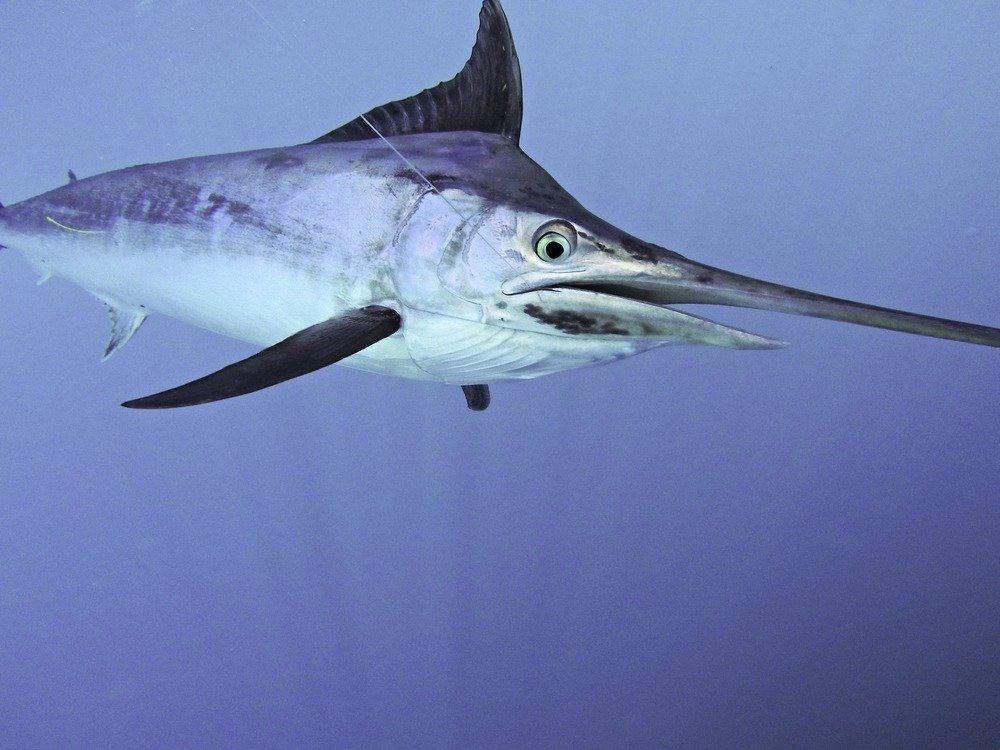Black Marlin
Istiompax Indica
Every black marlin is born as a female.
Advertisement
Black Marlin Scientific Classification
- Kingdom
- Animalia
- Phylum
- Chordata
- Class
- Actinopterygii
- Order
- Istiophoriformes
- Family
- Istiophordae
- Genus
- Istiompax
- Scientific Name
- Istiompax Indica
Read our Complete Guide to Classification of Animals.
Black Marlin Conservation Status
Black Marlin Facts
- Main Prey
- Fish, squid, octopods
- Fun Fact
- Every black marlin is born as a female.
- Estimated Population Size
- Unknown
View all of the Black Marlin images!
Black marlin are one of the largest bony fishes.
Usually found in the Indian and the Pacific oceans, the black marlin is a fish that comfortably exists in the tropical and subtropical areas and can swim at speeds of up to 80 miles per hour. It is a species of marline and has a maximum length of 4.65 meters. These marine creatures weigh around 1,653 pounds, and they belong to the family Istiophordae, which also includes sailfish.
The black marlin is considered the fastest fish in the world. Learn about the world’s fastest animals here.
5 Incredible Black Marlin Facts!
• Pointed dorsal fins: These marine creatures have anteriorly pointed dorsal fins.
• Hatched from eggs: They are hatched from eggs and are born as small fish. They grow rapidly year by year, eventually reaching a size that exceeds most fish sizes.
• Largest bony fish: These are known to be one of the largest bony fishes in the world.
• Granders: The black marlins that weigh above 1,000 pounds are called granders.
• Warm, tropical habitat: These marine creatures can be found in the warm waters of the Indian Ocean and the Pacific Ocean.
Black Marlin Classification and Scientific Name
Black marlins go by the scientific name Istiompax Indica and belong to the family Istiophordae and are closely related to sailfish. They come from the class Actinopterygii and order Istiophoriformes. The genus is Istiompax. Meanwhile, the kingdom is Animalia, and the phylum is Chordata.
With a close relation to the swordfish, the black marlin is one of seven different types of marlins. The word “indica” in their scientific name is Latin for “of India.”
Black Marlin Appearance
Black marlins are marine animals that have a shorter bill. Their dorsal fins are lower, and they also have a lower rounder. These fish can be easily differentiated from other marlin species since they have rigid pectoral fins that weigh around 150 pounds.
These marine creatures’ pectoral fin canopy is pressed flat to their bodies, and they can have anywhere between 39 to 50 dorsal rays. They are usually about 183 inches long and weigh around 1653 pounds.

©kelldallfall/Shutterstock.com
Black Marlin Distribution, Population, and Habitat
Black marlin are fish that are usually found in shallow waters. They exist close to continents, coral reefs, and islands and swim around the depth of zero to 915 meters. However, most of them rarely go below 30 meters. They are found in both tropical as well as subtropical waters of the Indian Ocean as well as the Pacific Ocean and can occasionally also enter the temperate waters.
Even though the population is not known, these marine creatures haven’t yet been declared threatened or endangered.
Black Marlin Predators and Prey
Black marlins usually feed on squid, cuttlefish, octopods, fish, and large crustaceans. As these fish go after their prey, some research shows that they will attack with a fast slash of their bill, which has been compared to that of the swordfish. The only time that these fish go after tuna is when the waters that they are in have them in abundance.
The only true threat these fish have is humans, who tend to hunt down the fish to sell or to keep as a trophy. Even though they tend to be high in mercury levels, they are still fished as food as well.
Black Marlin Reproduction and Lifespan
Black marlins reproduce by external spawning. They release eggs in warm waters that later hatch to become the fish babies and rapidly grow year by year. A pregnant female can carry up to 40 million eggs, which eventually hatch after a brief gestation period.
The females are known to live for about 11 years, while the males live only for 5 years. The difference in their lifespan is due to the sex-specific mortality in these marine creatures. Interestingly, at birth, all marlins are female, changing to preserve the species.
Black Marlin in Fishing and Cooking
This fish can be caught and cooked. However, despite being edible, it has been banned in some parts of the world because its body includes a high amount of selenium and mercury content. In fact, many chefs will recommend against consuming this fish, and it is considered one of the top big fish to avoid.
View all 285 animals that start with BBlack Marlin FAQs (Frequently Asked Questions)
What are the differences between marlins and swordfish
The primary difference between marlins and swordfish is that they belong to different families. Marlins live longer than swordfish, while swordfish are migratory.
Where are the black marlin found?
Black marlins are usually found in the tropical and subtropical waters of the Indian Ocean and the Pacific Ocean.
How fast can a black marlin swim?
Black marlins can swim at a speed of about 22-82 mph.
What is the difference between blue and black marlin?
Blue marlins have non-rigid pectoral fins while the black marlins have very rigid pectoral fins. Also, the blue marlins have blue colored bars all over their bodies. Black marlins are also closely related to sailfish and belong to the same family as well.
How long do black marlin live?
The female black marlins can live up to 11 years while the male black marlins can live up to 5 years. The difference in their lifespan is due to the sex-specific mortality.
How big are black marlin?
Black marlins are about 183 inches long in size and can weigh up to 1,653 pounds.
Are Black Marlin herbivores, carnivores, or omnivores?
Black Marlin are Omnivores, meaning they eat both plants and other animals.
What Kingdom do Black Marlin belong to?
Black Marlin belong to the Kingdom Animalia.
What phylum do Black Marlin belong to?
Black Marlin belong to the phylum Chordata.
What class do Black Marlin belong to?
Black Marlin belong to the class Actinopterygii.
What family do Black Marlin belong to?
Black Marlin belong to the family Istiophordae.
What order do Black Marlin belong to?
Black Marlin belong to the order Istiophoriformes.
What type of covering do Black Marlin have?
Black Marlin are covered in Scales.
What is the main prey for Black Marlin?
Black Marlin prey on fish, squid, and octopods.
What is the scientific name for the Black Marlin?
The scientific name for the Black Marlin is Istiompax Indica.
What is a distinguishing feature of the Black Marlin?
Black Marlins have rigid pectoral fins.
What is the biggest threat to the Black Marlin?
The biggest threats to Black Marlins are humans and human activities.
How do Black Marlins have babies?
Black Marlins lay eggs.
Thank you for reading! Have some feedback for us? Contact the AZ Animals editorial team.
Sources
- Wikipedia, Available here: https://en.wikipedia.org/wiki/Black_marlin
- Marlin, Available here: https://www.marlinmag.com/black-marlin/
- MarineBio, Available here: https://marinebio.org/species/black-marlins/istiompax-indica/
- Ocean Adventures, Available here: https://oceanadventures.co.za/black-marlin/
- Pelagic, Available here: https://pelagicgear.com/blogs/news/giant-black-marlin-undisputed-kings-of-billfish
- Science Direct, Available here: https://www.sciencedirect.com/science/article/abs/pii/S0165783614002720
- Fish Index, Available here: http://fishindex.blogspot.com/2009/12/black-marlin-makaira-indica.html
- The Healthy, Available here: https://www.thehealthy.com/food/best-fish-to-eat-and-never-eat/

















